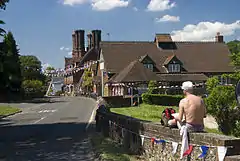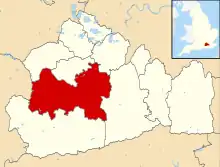| Albury | |
|---|---|
| Village and civil parish | |
 Albury village | |
 Albury Location within Surrey | |
| Area | 16.28 km2 (6.29 sq mi) |
| Population | 1,191 (civil parish 2011)[1] |
| • Density | 73/km2 (190/sq mi) |
| OS grid reference | TQ0447 |
| Shire county | |
| Region | |
| Country | England |
| Sovereign state | United Kingdom |
| Post town | Guildford |
| Postcode district | GU5 |
| Dialling code | 01483 |
| Police | Surrey |
| Fire | Surrey |
| Ambulance | South East Coast |
| UK Parliament | |
Albury is a village and civil parish in central Surrey, England, around 3.5 miles (5.6 km) east of Guildford. It is in the Surrey Hills Area of Outstanding Natural Beauty and the Borough of Guildford.
The civil parish covers an area of 1,628 ha (6.3 sq mi) and includes the settlements of Albury Heath, Farley Green, Little London and Brook. The area is drained by the River Tillingbourne and its tributaries, the Law Brook and the Sherbourne Brook.
Geography and economy
Albury civil parish spans the small village and three hamlets, which are Farley Green, Little London and adjacent Brook – spaced out by Albury Heath, Foxholes Wood, small fields and Albury Park. About a third of Blackheath Common on the Greensand Ridge is in the parish, which centrally nestles in the Vale of Holmesdale. The old village lay within what is now Albury Park. Albury new village is at the point where the Sherborne, flowing from near Newlands Corner via the Silent Pool, joins the Tillingbourne that runs through the centre of the village and until the 20th century powered Albury flour mill at the Chilworth edge of the village. The mill is now converted into offices and apartments. There is another watercourse leading into the Tillingbourne at Chilworth, the Law Brook, which the hamlet of Brook is centred on.
The 66-acre (27 ha) Colyers Hanger SSSI, an area of ancient woodland, is in the parish of Albury.[2]
According to the 2011 Census, the population was 1,191.[1] This was an increase of one since 2001 when the population lived in 527 homes (52 of which had their lowest floor level above street level and 298 of which were owner-occupied). While 583 people were economically active: 372 commuted by motor vehicle and 61 commuted by public transport, the average Albury commuter travelled 17 kilometres (11 mi).[3]
The village has a post office and general shop, and the "Drummond at Albury" inn; Little London has another public house the, "William IV", which dates back to the 16th century.[4]
The nearest railway stations are just beyond the borders: Chilworth, 1 mile (1.6 km) west, and Gomshall, 2 miles (3.2 km) east, of the parish boundaries, both on the North Downs Line.
History
The earliest written record of the village is from Domesday Book of 1086, in which it appears as Eldeberie. It is thought to be the settlement named Ældeburi and Ealdeburi in 13th-century copies of Anglo-Saxon documents from 933 and 1062 respectively, although this identification is not certain. In the 13th century, it is recorded as Aldebir (1242), Aldebiri (1253) and Audeburi (1284); the modern spelling "Albury" first appears in 1487. The name is generally agreed to derive from the Old English words ald (old) and burh (fortification), which may refer to the Romano-British camp at Farley Heath in the south of the civil parish.[5][6]
.jpg.webp)
The earliest evidence of human activity in the parish is from the Mesolithic.[8] Stone age artefacts found in the area include a flint blade,[9] an axe[10] and a scraper.[11] A small late Bronze Age settlement was excavated in the north of the parish in the 1960s.[12]
Farley Heath, in the southwest of the parish, has remains of a Romano-Celtic temple within a temenos in a clearing by Heath Road containing an inner cella, nearby a pottery kiln and tumbled columns can be seen.[13][14]
The entry for Albury in Domesday Book indicates that the manor was held by Roger d'Abernon from Richard de Tonebrige. Its assets were: 2½ hides, 1 church, 1 mill worth 5s, 8½ ploughs, 1-acre (4,000 m2) of meadow, woodland worth 30 hogs. It rendered £9.[15][16]
The medieval village of Albury was clustered around the old church of St Peter and St Paul, which has Saxon origins.[5][17] In 1842, Henry Drummond moved the rest of the village half a mile westward to what was originally the hamlet of Weston Street, where he also built a new church.[5][18] The Duke of Northumberland owns the estate – the Mansion was once home to the Duke and Duchess. The gardens are designated Grade I[19] and were designed by author and gardener John Evelyn whose family home was nearby at Wotton, 6 miles (9.7 km) to the east.

Albury village is next to Albury Estate which is an estate of 150 acres (0.61 km2). Within it is the Saxon church, the Mansion or Albury Park House, a Grade II* listed building.[20]

Sports
Fishing is available in the stocked Albury Estate ponds at Weston, Vale End, Albury Park and at Powder Mills, Chilworth with the Albury Estate Fisheries club.
Albury Cricket Club play at the Albury Heath ground that adjoins Albury Eagles FC, close to Albury and to Little London in Sandy Lane, the clubs have a combined social events calendar. The football club has several U16, U13 and U9 teams.[21]
Churches

The parish of Albury has four churches:
- The parish church of St Peter and St Paul,[22] built 1842 by McIntosh Brooks in red brick as a copy of the 12th-century Église Saint-Pierre [fr], Thaon, Normandy. The transept and apse were added in 1868 by Sir Arthur Blomfield, and the north chapel created as a Second World War memorial by neo-gothicist Sir Edward Maufe, designer of Guildford Cathedral.
- The Barn church, St Michael's in Farley Green.
- Old St Peter and St Paul's Church, a church of Saxon origin with 12th-century tower, 13th-century chancel, 14th-century nave and 16th-century north porch, Drummond Chapel (with marble chest tomb) and south window with quatrefoil renewed by Pugin: in Albury Park in the care of the Churches Conservation Trust, a Grade I listed building.[17]
- The Catholic Apostolic Church graded II*, also built by McIntosh Brooks,[23] is by the Sherbourne brook at the northeast end of the village street near to where it joins the A25.
Demography and housing
| Output area | Detached | Semi -detached | Terraced | Flats and apartments | Caravans mobile homes | Shared housing |
|---|---|---|---|---|---|---|
| (Civil Parish) | 235 | 134 | 56 | 51 | 3 | 0 |
The average level of accommodation in the region composed of detached houses was 28%, the average which were apartments was 22.6%.
| Output area | Population | Households | Owned outright | Owned with a loan | hectares |
|---|---|---|---|---|---|
| (Civil Parish) | 1,191 | 479 | 34.2% | 27.1% | 1,628 |
The proportion of households in the civil parish who owned their home outright compares to the regional average of 35.1%. The proportion who owned their home with a loan compares to the regional average of 32.5%. The remaining % is made up of rented dwellings (plus a negligible % of households living rent-free).
Albury landfill

Albury landfill site was granted a waste disposal licence in November 1989. The 56-acre (23 ha) site, a former sand quarry to the north of the village, was adapted to hold household waste in storage cells lined with a waterproof membrane to prevent groundwater contamination.[24][25] In 2013, the operators were fined for allowing leachate to escape from the site over a four year period.[26] Since 2008, biogas produced by the decaying waste has been collected for use as a vehicle fuel.[27][28]
References
- 1 2 3 4 Key Statistics; Quick Statistics: Population Density Archived 11 February 2003 at the Wayback Machine United Kingdom Census 2011 Office for National Statistics Retrieved 21 November 2013
- ↑ "The citation of the SSSI in the parish" (PDF). Natural England – SSSI body. Archived from the original (PDF) on 24 October 2012. Retrieved 7 May 2012.
- ↑ "2001 Census". ONS. Archived from the original on 10 June 2015. Retrieved 7 May 2012.
- ↑ Historic England. "King William IV public house (Grade II) (1377783)". National Heritage List for England.
- 1 2 3 Gover, J.E.B.; Mawer, A.; Stenton, F.M. (1969). The place-names of Surrey. Cambridge: Cambridge University Press. pp. 219–220.
- ↑ Field, John (1980). Place-names of Great Britain and Ireland. Newton Abbot, Devon: David & Charles. p. 22. ISBN 978-0-71-537439-9. OCLC 6964610.
- ↑ Williams, David (4 August 2010). "Finds record for: SUR-983A36". The Portable Antiquities Scheme. Archived from the original on 29 October 2020. Retrieved 11 October 2023.
- ↑ Machin, E.L. (1976). "Report on the Mesolithic Industry of Weston Wood, Albury" (PDF). Surrey Archaeological Society Research Volumes. 3: 103–111. Retrieved 11 October 2023.
- ↑ Maslin, Simon (8 June 2023) [17 August 2021]. "Finds record for: SUR-BB3CF6". The Portable Antiquities Scheme. Archived from the original on 28 March 2023. Retrieved 11 October 2023.
- ↑ Williams, David (9 August 2010). "Finds record for: SUR-FD4E38". The Portable Antiquities Scheme. Retrieved 11 October 2023.
- ↑ Maslin, Simon (27 January 2023) [26 January 2023]. "Finds record for: SUR-26E2BC". The Portable Antiquities Scheme. Archived from the original on 28 March 2023. Retrieved 11 October 2023.
- ↑ Harding, Joan M. (1964). "Interim Report on the Excavation of a Late Bronze Age Homestead in Weston Wood, Albury, Surrey" (PDF). Surrey Archaeological Collections. 61: 10–17. doi:10.5284/1068936.
- ↑ Romano-Celtic temple: Historic England. "Details from listed building database (1005941)". National Heritage List for England. Retrieved 7 May 2012.
- ↑ "Details of Farley Heath temple". Roman Britain. Archived from the original on 3 June 2012. Retrieved 7 May 2012.
- ↑ Surrey Domesday Book Archived 30 October 2007 at the Wayback Machine
- ↑ Powell-Smith, Anna (2008). "Albury". Open Domesday. Archived from the original on 27 February 2023. Retrieved 11 October 2023.
- 1 2 Historic England. "The old parish church of St Peter and St Paul (Grade I) (1294958)". National Heritage List for England.
- ↑ 'Parishes: Albury', in A History of the County of Surrey: Volume 3, ed. H E Malden (London, 1911), pp. 72-77. British History Online http://www.british-history.ac.uk/vch/surrey/vol3/pp72-77 Archived 31 July 2018 at the Wayback Machine [accessed 24 August 2018].
- ↑ Historic England. "Albury Park (Grade I) (1000299)". National Heritage List for England.
- ↑ Historic England. "Albury Park (Grade II*) (1029565)". National Heritage List for England.
- ↑ "Albury Eagles". Archived from the original on 3 April 2012. Retrieved 7 May 2012.
- ↑ Historic England. "Church of St Peter and St Paul (Grade II) (1029561)". National Heritage List for England.
- ↑ Historic England. "Catholic Apostolic Church and Chapterhouse (Grade II*) (1029568)". National Heritage List for England.
- ↑ "Tip site operators seek licence change". Dorking Advertiser. No. 5346. 4 March 1993. p. 4.
- ↑ "We can no longer 'bury our heads'". Surrey Live. 3 July 2013 [5 October 2007]. Archived from the original on 19 October 2021. Retrieved 11 October 2023.
- ↑ Bodkin, Henry (15 May 2015). "Judge reduces fine for negligent running of Albury landfill site". Surrey Live. Archived from the original on 16 May 2022. Retrieved 11 October 2023.
- ↑ "Landfill gas used to make biomethane vehicle fuel". ENDS Report. 22 August 2008. Archived from the original on 21 September 2020. Retrieved 11 October 2023.
- ↑ Doczekal, Christian; Gruevska, Ana; Rutz, Dominik; Morales Aguilar, Inés; Bel, Jean-Benoit; Pukšec, Tomislav (May 2016). "Report on good practice of biomethane usage as a transportation fuel". European Commission.
